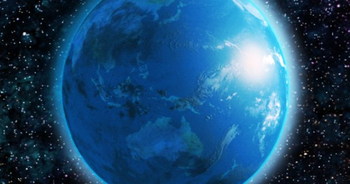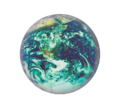PNF-404
PNF-404 is the planet that Olimar lands on, in both Pikmin and Pikmin 2, and where Alph, Brittany, and Charlie land on in Pikmin 3. It is the natural habitat of Pikmin as well as many other lifeforms, many of them predators of the Pikmin. The planet is known as the planet of the Pikmin or the Pikmin planet in the first two games, but the scientific name "PNF-404" comes from Koppai. In the Super Smash Bros. series, it is known as Distant Planet.
In Pikmin, Olimar crash lands on this uncharted planet during his vacation after his ship is struck by a meteoroid; Olimar must escape the planet before his life support system fails because the atmosphere contains oxygen which is toxic to Olimar's people.
In Pikmin 2, Olimar returns to the planet with his new companion, Louie, in search of treasure, in order to rescue the company he works for, Hocotate Freight, from bankruptcy.
In Pikmin 3, Alph, Brittany, and Charlie land on PNF-404 to collect food to save Koppai from a food shortage.
The planet appears in Super Smash Bros. Brawl and Super Smash Bros. for 3DS as a fighting stage under the name Distant Planet. It features a forested section of the planet, similar to the Awakening Wood or The Forest of Hope. In Super Smash Bros. for Wii U, a new arena replaces Distant Planet, this one based on the Garden of Hope.
The planet as Earth
While room is left for ambiguity, there is an impressive amount of evidence that PNF-404 is Earth, or at the very least a planet with highly similar geography to Earth. Several views of the planet reveal the distinctive continental shapes of Africa, Southeastern Asia, Antarctica, South America, and Australia, while the Spherical Atlas and Geographic Projection are two halves of a globe that clearly show Earth and its countries. Finally, the technical filename of the Distant Planet stage in Super Smash Bros. Brawl is STGEARTH, making it clear that at the very least the Brawl developers see the planet as Earth.
In an interview with Shigeru Miyamoto, he states that PNF-404 is in a state where humans are extinct [Needs citation]. This explains why no human life-forms are encountered during the entire duration of the game. Pikmin 2's areas are comparable to those in its prequel, and there are new human objects, which can only be described as remnants of society before humans died out.
Whether or not PNF-404 actually is our Earth or an alternate version is yet to be revealed in the games or by Shigeru Miyamoto, the game's creator; either way, it is doubtful that the similarities are coincidental. Tin cans as well as many other man-made objects and structures from modern times can be found lying around in the first game (for example, parts of Perplexing Pool and The Distant Spring appear to be the remains of a bathroom), and most of the 'treasures' found in the second game are man-made or objects natural to Earth. These even include many items that are registered trademarks of existing companies, such as 7-Up and Duracell.
In the first game, cardboard boxes scattered across the areas with 10s on them indicate that humans were living or had lived at that time. However, the proportion of these objects compared to Olimar's size in the instruction manual make this a bit unjustified, as the cardboard box would be the size of a matchbox at most. Furthermore, there are many different creatures to what we know at the present day. Perhaps this is an entirely new age where humans have died out and many other creatures have come to exist peacefully. Another reason that the Pikmin Planet could be Earth is because in the first game, Olimar stated that the atmosphere is composed of high levels of oxygen, the component of the air that humans need to breathe, but also an extremely toxic gas to the people of Hocotate. This statement is also misleading, however, as the most prevalent gas in Earth's atmosphere is Nitrogen.
The Geiger Counter is constantly in action, implying that there is strong and constant radiation. That could explain why there are no humans anymore, and also why all creatures on PNF-404 look so different compared to how animals looked when humans were alive.
During the second game, this statement is supported: when Olimar lands on or leaves the planet his ship is shown to be heading towards or coming from Africa. Most of the planet's geography has been shown to match Earth's, the Ship even stating at the time of the discovery of the Spherical Atlas that it exhibits PNF-404's geography as seen from space: both this and the Geographic Projection are two halves to a globe that clearly shows Earth and its countries.
All this considered, Pikmin 3 adds a new wrinkle into the equation: the area selection map shows that extreme continental drift has occurred since Pikmin 2, with Antarctica becoming a tropical paradise and merging with Australia, and southeastern Asia becoming a cold tundra. This new map layout resembles Pangea Ultima, a prediction of the continents in 250 million years.
In the Super Smash Bros. series
|
This article or section is a short summary on the Brawl and SSB4 stage. |
In Super Smash Bros. Brawl and Super Smash Bros. for 3DS, there is a stage named Distant Planet. It features a background similar to the Awakening Wood, while the foreground is consisted of some vines, leaves and a slope. A Red Bulborb occasionally appears on the right side of the screen, which can be stood on. It may open its mouth, and any fighters that fall in are eaten and lose a stock. An Onion of a random color drops from the sky at times. Pellet Posies also grow at certain times, and, if hit enough, they'll drop their pellet. If the fighters grab a pellet and throw it at an Onion, items will spawn from it, with the amount depending on the pellet's number (leaving a Pellet Posy alone slowly upgrades it from a 1 to a 5 and then 10) and whether it matches the Onion's color. Damaging an Onion enough will cause it to fly away prematurely.
As with many Smash Bros. stages, a few liberties have been taken from the original source. Firstly, rain pours from time to time, which does not occur in the Pikmin series until Pikmin 3. Secondly, decorative content such as a Super Smash Bros.-themed soda has been added. Finally, the Red Bulborb is much larger in Brawl than in the Pikmin games, at about four or five times the size.
Super Smash Bros. for Wii U also contains a stage from an area in PNF-404. This one is titled exactly the same as the Garden of Hope, and is much more faithful to the actual game area than the arena in the previous games.
Gallery
The planet as seen in the Pikmin 2 intro cut-scene. The ship's engine glows over what appears to be somewhere in Africa as it lands.
- Pikmin3~Earth.png
The planet as seen on the log screen in Pikmin 3.
- OMGPIKMIN3MAPISAWESOMEILOVEYOUMIYAMOTO.png
A picture showing correlation between PNF-404 and Pangea Ultima, what Earth is predicted to look like in 250 millions years from now.
Trivia
- The name "PNF-404" fits the naming nomenclature used by NASA to identify less important planets. The letters and numbers that make up the name, however, have a special meaning: 404 is an HTTP status code that means "Page Not Found".
See also
External links



